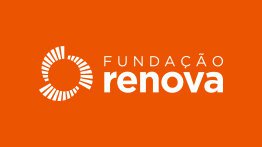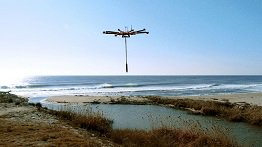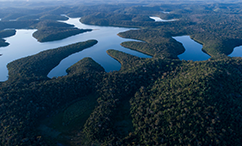
38 – Monitoring of the Doce river basin
Objective of the program
To develop and to implement a systematic quantitative and qualitative monitoring program (SQQMP or PMQQS in the Portuguese acronym) of water and sediments, which also includes a toxic and ecotoxic risk assessment
7th newsletter of PMQACH untreated points.
Protocol of the 12th newsletter of the WTPs that collect from the Doce River in the PMQACH.
7th newsletter of points with treatment that are captured from other PMQACH sources.
Approval of technical note 117 by CIF regarding the 3rd review of the PMQQS through deliberation 817.
Exhibition to the school community of the work carried out by students during the workshops of the Institutional Psychopedagogical Support project.
Support for the production of the Gincana in the schools of Bento Rodrigues and Sinho Machado Santa Rita Durão in Mariana.
Protocol of the proposal for the third revision of the PMQQS
Technical visit to the ALS unit in Contagem (PMQACH)
Approval of the 11th newsletter of Monitoring Water Quality for Human Consumption (PMQACH) of treated water with water withdrawal in the Doce River, the 6th newsletter of treated water without withdrawal in the Doce River and the 6th newsletter of points without treatment.
Approval of the Second Biannual Review of PMQACH
Training given by CETESB on Collection and preservation of water and sediment samples in aquatic environments that took place in Serra-ES.
Changing the laboratory that runs PMQACH
Second visit by CT Saúde to the Bioagri laboratory in Serra
Delivery of the 11th newsletter of treated systems that capture water from the Doce River".
6th newsletter of treated systems that capture water from other sources.
6th newsletter of alternative solutions without treatment.
Visits carried out by Technical Board of Health at Bioagri laboratories in Belo Horizonte.
Visits carried out by Technical Board of Health at Bioagri laboratories in Serra.
Visits carried out by Technical Board of Health at Bioagri laboratories in Piracicaba (SP).
Approval of PMQACH annual report 2022-2023.
Protocol of Official Letter FR.2024.0825 referring to the quarterly QA/QC Report from October to December 2023.
No progress this month.
PMQACH - Official Letter Protocol FR.2024.0099 referring to the 10th newsletter of treated systems that capture water from the Doce River; 5th newsletter of treated systems that capture water from other sources; 5th newsletter of alternative solutions without treatment.
Start of the 2nd revision of PMQACH with a new laboratory.
QA/QC Quarterly Report Protocol Jul to Sep 2023 - PMQQS.
Protocol of the Second biannual review of PMQACH.
PMQACH Annual Report 2022-2023
No progress this month
Protocol of the 9th newsletter with treatment that captures from the Doce River and 4th newsletter of points without treatment and points with treatment from other sources of water withdrawal
Quarterly QA/QC protocol PMQQS, from April to June/23.
Protocol of Official Letter FR.2023.1904 referring to the Executive Report of the PMQQS Quality Assurance and Control Program (QA/QC).
Protocol of the letter FR.2023.1575 referring to the Newsletters containing the results of monitoring the quality of water for human consumption.
Protocol of the letter FR.2023.1055 referring to the Newsletters containing the results of monitoring the quality of water for human consumption.
Protocol of the letter FR.2023.0503 and annexes referring to the clarifications requested through the Letter No. 09/2023/CIF/GABIN, which deals with the Action Plan for Rainy Periods.
Protocol of the letter FR.2023.0718, referring to making new adjustments to the document of the 2nd Biannual Review of the PMQQS, to comply with NTn°99 of the GTA-PMQQS.
Protocol of the letter FR.2023.0730 and annexes referring to the Quarterly QA/QC Report of the PMQQS from October to December/22.
Protocol of official letter FR.2023.0283, in compliance with Official Letter TB-Health No. 11/2023, forwarding the revised ETA Newsletters.
Protocol to official letter FR.2023.0254 regarding the communication on the analysis of mercury in PMQQS MPS samples.
Report Protocol on Resumption of Operation and Structural Adjustments in the Automatic Monitoring Stations of the PMQQS, in response to Technical Note No. 93 GTA-PMQQS.
Protocol for the Report on the Monitoring Plan for Water Quality for Human Consumption – PMQACH – 2021-2022, in compliance with CIF Resolution No. 513/2021.
Protocol of actions to adapt the methodology for the analysis of total mercury in water and sediment, in compliance with CIF Resolution No. 625.
Document protocol of the Second Biannual Review of the PMQQS, in response to CIF Resolution No. 638.
Information letter protocol on prospecting laboratories that carry out ecotoxicological tests on sediments with Chironomidae, in response to Technical Note No. 95 of GTA-PMQQS.
Response to OFFICIAL LETTER No. 212/2022/CIF/GABIN - Request for an Action Plan for Rainy Periods.
Protocol of the Quarterly Report of the Quality Assurance and Control Program (QA/QC) of the physical-chemical, hydrobiological, ecotoxicological, granulometry, MPS, liquid discharge and solid discharge of the PMQQS for the period from July to September 2022.
Liquid Discharge Technical Report Protocol: Consistency Analysis and Key Curves, referring to the second cycle of the PMQQS, February 2021 to December 2021.
Protocol of response to Official Letter TB-Health/CIF No. 118/2022 – Bulletins on Monitoring the Quality of Water for Human Consumption (PMQACH).
Completion of the New Monitoring Doce River Portal
There were no relevant facts this month.
Protocol of the Quality Control and Assurance Report (QA/QC) Quarterly of the PMQQS from April to June/22.
Official protocol of compliance with the technical training of the team responsible for monitoring water and sediment, to comply with item 2.3.1 - Quality Assurance (QA) of the PMQQS.
Protocol of the Executive Summary of the 2nd cycle of the Quality Control and Assurance Protocol (QA/QC) of the PMQQS.
Protocol of PMQACH Newsletters in compliance with CIF Resolution No. 513 and NT54/2021 of CT-Saúde.
The second and final stage of the II PMQQS Review Seminar was held in Vitória.
Training on the PMQQS Training Plan for Liquid and Solid Discharge was carried out with the participation of the Renova Foundation, Outsourced and GTA-PMMQS teams
The first stage of the PMQQS Bi-annual Review Seminar held in BH
Meeting between GTA-PMQQS and Fundação Renova for the PMQQS NewMonitoring Doce River Portal Project.
Meeting between GT-Water (TB-Health) and Renova and presentation protocol of the Models of the Monitoring Newsletters of the Quality of Water for Human Consumption (PMQACH).
Protocol of response to NT 93 of the GTA-PMQQS with presentation of the report of evidence supporting the adjustments made in the automatic monitoring stations of the PMQQS.
Protocol of the Quarterly Control and Quality Report (QA/QC) of the PMQQS data for the months from January to March 2022.
A meeting was held between the Renova Foundation and GTA-PMQQS to discuss new adjustments to the New Portal Project.
Technical visit was carried out by TB-Health members to the Tommasi laboratory hired for carrying out the collections and analysis of the PMQACH.
On 05/17, the adjustments made in the Monitoring Portal Review Project were forwarded to the GTA-PMQQS
Protocol of Edition 5 of the Water Quality Monitoring Bulletin for Human Consumption, referring to the period from September 17, 2021 to January 16, 2022.
Protocol of the Proposed Scope of the Quali-quantitative Monitoring Plan for the Waters of the Doce River and its tributaries as a function of the Interventions - PMQQVAI, to comply with Item 3 of CIF Resolution No. 572
Protocol of review of the 2020-2021 PMQACH Report, in compliance with TB-Health Official Letter 12/2022 and in compliance with CIF Resolution No. 513 (and Resolution 301).
A meeting was held with the GTA-PMQQS on 04/20 to discuss the New Monitoring Doce River Portal.
Protocol of the Quarterly Data Consistency Report (QA/QC) of the PMQQS for the months from October to December/21.
Protocol of the Proposed Scope of the Gualaxo do Norte River Flood Monitoring Project, in compliance with Item 4 of CIF Resolution No. 572
Protocol of the Final Report “Sampling plan for the Monitoring of the Quality of Water, Sediments and Unconsolidated Material in the dikes S3, S4, Nova Santarém dam and Gualaxo do Norte river”, in compliance with CIF Resolution No. 310
Meeting with GTA-PMQQS held on 03/11 for discussions on the development of the new prototype of the Monitoring Doce River portal
Meetings with the GTA for discussions on the development of the new prototype of the Monitoring Doce River portal
Inform about the resumption of data transmission from automatic stations and manual collections (PMQQS).
Revised Protocol of the 4th edition of the Monitoring Bulletin of the Quality of Water for Human Consumption (PMQACH)
Report on temporary interruption of data transmission from automatic stations and impediment of manual collections (PMQQS) due to rains that occurred in the first
Delivery of the prototype of the new Doce River Monitoring Portal
Presentation of the 2020-2021 PMQACH Report
Quarterly QA/QC Report of Rivers and Sea Monitoring (PMQQS) - Jul/21 to Sep/21
Protocol of Edition 4 of the Water Quality Monitoring Bulletin for Human Consumption
PMQQS automatic station relocation - RDO 02
QAQC Report Protocol of the two sampling campaigns of the "Sampling Plan for Monitoring the Quality of Water, Sediments and Unconsolidated Material in the S3, S4 dikes, Nova Santarém Dam and Gualaxo do Norte River" - Compliance with CIF Resolution No. 310
PMQQS QA/QC Quarterly Report Protocol from April to June/21.
Report of the change from RDO2 Automatic Monitoring Station to RDO02J - Compliance with Technical Note No. 55 of GTA-PMQQS
Protocol of the Bimonthly Quality Assurance and Control Report (QA/QC) of PMQQS data - Feb/21 to Mar/21
3rd Water quality monitoring bulletin for human consumption filed at Technical Board of Health
Final delivery of laboratory analysis reports from the second campaign of the “Sampling Plan for Monitoring the Quality of Water, Sediments and Unconsolidated Material in the S3 and S4 dikes, Nova Santarem Dam and Gualaxo do Norte River”;
Revised Protocol of the Water for Human Consumption Monitoring Plan (PMQACH), and its respective annexes, in compliance with CIF Resolution No. 513, based on Technical Note No. 54/TB-Health and Official Letter No. 017/2021/TB-Health /CIF.
Official Letter TB-Health/CIF No. 19/2021 approves the 2015-2020 PMQACH Annual Report, in compliance with Resolution 301 and NT52/2021
Compliance with CIF Resolution No. 310 - partial protocol (3rd and 4th shipment) of the laboratory analysis reports of the Colloids collection campaign
PMQACH 2015 – 2020 Report revised, in compliance with CIF Resolution No. 301 and Technical Notes No. 52/2021 and No. 34/2020 of TB-Health
Official Letter in Compliance with Item 3 CIF Resolution N°458
Response Resolution CIF 511 - Executive Summary QAQC PMQQS
Protocol of the Second Edition of the Water Quality Bulletin for Human Consumption, referring to data from December 2020 to March 2021
Presentation Technical Liquid Discharge Report: Consistency Analysis and Curves - Key, in response to Technical Note No. 56 of GTA-PMQQS
Filed the Quarterly Report of the Quality Assurance and Control Program (QA/QC) of hydrobiological, ecotoxicological, granulometry, sediment core, MPS, liquid discharge and solid discharge of the PMQQS study for the period from Oct/20 to Jan/21.
Filed the Biannual Review of the PMQQS in compliance with NT78 GTA-PMQQS
Filed the response to NT82 GTA-PMQQS about the PMQQS Training Plan
Filed the 2nd remittance of the reports of the Second Colloids Campaign, in compliance with CIF resolution 310
CT-SHQA: Filed part of the Reports of the 2nd Colloids Collection Campaign, in compliance with CIF resolution 310.
TB-Health (“CT-Saude”): Filed the Water Quality for Human Consumption Bulletin.
CT-SHQA: Filed the newsletter on the new format and periodicity for the next reports of the Quali-Quantitative PMQQS program.
CT-SHQA/GAT: Filed the monthly report of the rainy season plan (March/2021) in compliance with CIF resolution 378.
Filed the monthly QA/QC Report - Jan/21
Filed the monthly report of the rainy season plan (Fev21) in compliance with CIF resolution 378.
Filed the partial report referring to the 1st Colloids sample collection in the dry season, in compliance with CIF resolution 310
Filed the monthly QA/QC Report PMQQS - Dec 2020
Filed the monthly Rainy Season Report - January 2021
Filed the document on the Transition of the PMQQS Execution Contract. Tommasi Ambiental Laboratory, together with its partners, will carry out the monitoring of the revised PMQQS starting February 2021, carrying out sampling related to monthly, quarterly, half-yearly and annual campaigns.
Filed the Quarterly Report QA/QC Jul/20 to Sep/20 (PMQQS).
Filed the Monthly QA/QC Report Nov/20 (PMQQS).
Filed the PMQACH 2015-2020 Report - In compliance with Resolution No. 301 and NT22/2019/TB-Health.
Filed the monthly report of the Rainy Season Plan in compliance with CIF resolution 378.
Filed the second part of the laboratory analysis reports of the first collection campaign and notification about an error in the ecotoxicity in sediment samples collected for the Monitoring of Water Quality, Sediments and Unconsolidated Material at dikes S3, S4, Nova Santarem dam and Gualaxo do Norte River, in compliance with CIF Resolution No. 310.
Resumed the Operation of the Automatic Monitoring Stations RCA02 and RDO01 after the interruption of operation due to rainfall that occurred in January 2020. On 11/23.
Protocol of the PMQQS Executive QAQC Summary - 3 years compiled. On 11/17.
Protocol for the positioning of the Renova Foundation regarding Technical Note No. 69_GTA-PMQQS. On 11/12
Compliance with CIF Resolution No. 310 - Delivery of part of the laboratory analysis reports of the first collection campaign of the Sampling Plan for the Monitoring of Water Quality, Sediments and Unconsolidated Material at dikes S3, S4, Nova Santarem dam and Gualaxo do Norte River. On 11/17.
Final Delivery and Dissemination of the PMQQS Online Platform www.monitoramentoriodoce.org on 10/30, in compliance with CIF Resolution nº 455.
Filed the Monthly QAQC PMQQS for SET/20 on 10/26.
Resumed the Operation of the Automatic Monitoring Station RDO04 on 10/23, after the interruption of operation due to rainfall that occurred in January 2020.
The action of data generated by the PMQQS contained in NT 16/GT-PMQQS
- Monthly QAQC PMQQS Report for JUL/20 on 09/30.
Filling of the Prototype for the PMQQS Online Platform on 09/03.
PG38 Program Definition Protocol revised on 09/30.
Resolution 444 of 09/18/20 approving the new data publication flow by Renova and CIF based on data validation and qualification criteria in the data generated by the PMQQS contained in NT 16/GT-PMQQS.
Filing of the Qqc Pmqqs quarterly report for the quarter Feb to Apr / 20 on 07/08/2020.
* Filing of the monthly report QAQC PMQQS for the month of JUL/20 on 28/08/2020.
There were no significant developments in the last month
Quali-Quantitative Systematic Monitoring Plan (PMQQS)
• Filed on 7/31/2020, the Bi-annual Review of the Quali-Quantitative Water and Sediments Systematic Monitoring Program (PMQQS).
• Filed on 7/15/2020, the Quarterly Report of the Quality Assurance and Control Program (QA/QC) of the biological data of the PMQQS for the period from November 2019 to January 2020.
• On 7/13/2020 started the development of the PMQQS Online Platform - Monitoring of the Doce River.
• PMQQS collections were resumed on July 6, 2020. Of the 92 points, it was not possible to collect samples at 19 points. Of these points, 3 were in the Samarco area, where until then access was restricted; at 1 point, no sediment was collected because the access point was inaccessible due to works in progress by the municipality of Raul Soares; 6 points in Barra Longa, where there is a sanitary barrier decreed by the municipality; and 9 in some communities where AFE aid was suspended.
Water Quality for Human Consumption Monitoring Plan (PMQACH)
• PMQACH collections were resumed on June 29, 2020. In July, 56 points were monitored, including supply systems and collective alternative solutions, defined by the Technical Board of Health.
Quali-Quantitative Systematic Monitoring Plan (PMQQS)
• Implementation of a digital format for the Doce River Expedition in partnership with Google.
• Approval for publication of the physical-chemical and biological community parameters of the water and sediment matrices in the quarterly QA/QC report, referring to the period from May to July 2019.
• Filed the Monthly Report of the physicochemical data of the PMQQS, of March 2020, of the Quality Assurance and Control Program (QA/QC).
Quali-Quantitative Systematic Monitoring Plan (PMQQS)
• Protocol for the Monthly Report on the Quality Assurance and Control Program (QA/QC) for physicochemical data from the PMQQS, pertaining to January 2020.
• Protocol for the Monthly Report on the Quality Assurance and Control Program (QA/QC) for physicochemical data from the PMQQS, pertaining to February 2020.
Quali-Quantitative Systematic Monitoring Plan (PMQQS)
• Protocol of the Monthly Report of the Quality Assurance and Control Program (QA/QC) of the physicochemical data of the PMQQS, referring to December 2019.
• Implementation of review and improvement in the process by making data available in the QQ/QC reports of the PMQQS.
Quali-Quantitative Systematic Monitoring Plan (PMQQS)
• Protocol of the PMQQS Simplified Quarterly Report, from October 2019 to December 2019.
• Protocol of the Monthly Report of the Quality Assurance and Control Program (QA/QC) of the physicochemical data of the PMQQS, referring to November 2019.
• Protocol of the Quarterly Report of the Quality Assurance and Control Program (QA/QC) of the biological data of the PMQQS, referring to the months of August 2019 to October 2019.
• Environmental awareness actions for the Doce Alive Project in the communities of Ilha Brava/MG and Baguari/MG.
Quali-Quantitative Systematic Monitoring Plan (PMQQS)
• Resumption of the activities of the automatic stations RDO 02 and RDO 03, located in the Doce River upstream and downstream of the Risoleta Neves Hydroelectric Plant (Candonga), after the damage suffered by the January/2020 floods.
• First alignment and planning meeting between the Renova Foundation and GTAPMQQS (Technical Monitoring Group), for the definition and construction of the PMQQS online platform.
• Signed the contract for the development of the investigation study of the unconsolidated material that is to examine the impact of tailings contamination through measuring the colloidal fraction.
Quali-Quantitative Systematic Monitoring Plan (PMQQS)
• On 01/24/2020, a meeting was held with the community of Gameleiros/ES, district of Sao Mateus/ES, in order to present the water quality monitoring program and the most recent results in the region.
Water Quality for Human Consumption Monitoring Plan (PMQACH)
• On 01/14/2020, PMQACH water collections were resumed in Degredo/ES.
• On 01/20/2020, the informative PMQACH material was presented to the Technical Board of Health. This material is for the public and provides information on the monitoring program and the reason for the collections.
There were no relevant deliveries this month.
PMQQS - River and Sea Monitoring
• Environmental awareness action at the school in the town of Sem-Peixe/MG, with the objective of making children aware of water use, as well as presentation of monitoring activities in the Doce River Basin carried out by the Renova Foundation.
• Participation in the 1st Positive Actions Caravan in Governador Valadares/MG, which aimed to present the monitoring program and provide general information on water and sediment quality to the Fishermen's Association of the Colony.
• Participation in the XXIII Brazilian Symposium of Water Resources in Foz do Iguaçu/PR, with the purpose of presenting a summary of the water quality monitoring program to the main authorities in Brazil.
• Submission of the PMQQS simplified quarterly report for the period July to September 2019, which analyzes parameters of monitoring points distributed along rivers and lagoons.
• Submission of the quarterly QA/QC Report of the PMQQS data for the period May 2019 to July 2019.
PMQQVAI - Water Monitoring Near Interventions
• Submission of the PMQQVAI final report, which compiles the results of the monitoring program's analyses conducted near the interventions.
PQMACH - Water Monitoring for Human Consumption
• Completion of the elaboration of the PMQACH booklet, with content that clarifies the roles of the Renova Foundation in issues related to the results of water analysis for human consumption, the choice of monitoring points and the determination of the parameters analyzed.
• In October, environmental education actions were carried out in schools in the municipalities of Sobralia, Fernandes Tourinho and Aracruz, aimed at raising awareness of water use as well as the presentation of water monitoring activities in the Doce River Basin by the Renova Foundation.
• On 10/16, there was a meeting between GTA-PMQQS and the Renova Foundation, to align and clarify Technical Note 46, regarding the Proposed Biennial Review of the Quali-Quantitative Systematic Monitoring Program (PMQQS) of Water and Sediments.
• On 10/24, the 1st half-yearly PMQACH report was filed, which addresses the results of the analysis of the first to sixth water sample collection campaigns.
• On 10/31, training was given by the Renova Foundation to the State Water Resources Agency of Espirito Santo (AGERH) on the PMQQS database (MP5) in order to provide explanations on how to use the platform for consulting data and reports generated through the software.
• Revision and approval of the River and Sea Monitoring Guidelines (PMQQS) has been rescheduled for February as GTA-PMQQS will revise NT 46/2019 following comments by the Renova Foundation.
PMQQS:
• On 09/23/2019, the Renova Foundation received technical note no. 46 from GTA-PMQQS, referring to the proposal for a bi-annual review of the Quali-Quantitative Systematic Monitoring Program (PMQQS) for Water and Sediment. Based on the new CIF guidelines and subsequent resolution, a meeting will be held to align with the PMQQS points reviewed by the NT.
• The revision and approval of the river and sea monitoring guidelines (PMQQS) were rescheduled for October 19, because even with NT 46/2019, GTA-PMQQS requested a meeting to align the points that were revised after the CIF deliberation.
PMQACH:
• The protocol for the semi-annual Human Consumption Water Monitoring (PMQACH) report, which addresses the results of analyses from the first to sixth collection campaigns, was rescheduled for October 19, following the task force of the technical team to review the report produced by the consultancy agency.
• On 08/15/2019, a workshop was concluded at the Dom Cabral Foundation to discuss the guidelines of the biannual review of river and sea monitoring in the Doce River Basin (PMQQS). The workshop was attended by representatives of the Renova Foundation, environmental agencies, GTA-PMQQS, Technical Boards (Health, SHQA, Bio, ECLET), Prosecution Service, among others.
• Change of communication strategy, seeking greater engagement and integration with communities through meetings, lectures and workshops to show the activities and results of the Doce River Basin monitoring.
PMQACH:
• Protocol of the 1st half-yearly PMQACH report, which addresses the results of the analysis for the first to sixth water sample collection campaigns. This delivery was rescheduled for September/2019, due to revisions of the water analysis reports to comply with TB-Health requests.
PMQQS:
• On 06/03/2019, the 1st annual PMQQS report was filed with the results of all analyses performed in the PMQQS study, at all sample collection points.
PMQQS:
• On 05/31/2019, the second quarterly report of the PMQQS was filed, whose scope was defined by NT. no. 19 of GTA-PMQQS, addressing the results of 18 physicochemical parameters at points in rivers and lagoons.
• Technical team to review the 1st annual PMQQS report to file with the CIF on the first working day of June.
• CIF Resolution 275, establishing the immediate suspension of the PMQQVAI, based on NT 32 of the Working Group GT-PMQQS.
• Presented PMQQS monitoring results to the Colatine Fishermen's Association.
• Inspection by GTA-PMQQS (IEMA/IBAMA) to supervise the collection of samples in Rio Doce and Colatina.
On 03/08/19, were filed with the CIF, the QA/QC Report (data validation of samples and completed analyses) and the simplified quarterly report of the PMQQS (quarter Aug/18 to Oct/18).
Filed, the first quarterly report of the Quali-Quantitative Monitoring Plan of Interventions (PMQQVAI) for interventions and works of the Renova Foundation, in order to identify if they cause impacts in the Doce River Basin.
A meeting was held with the community of Regencia to present the article on the explosive growth of bacteria and its consequences.
Approved by the Technical Board for Water Security and Quality is the new model of the Weekly Water Quality Bulletin during the rainy season. The document can be accessed on the website: https://www.fundacaorenova.org/wpcontent/uploads/2019/01/boletim-semanal-periodo-chuvoso_28.01.2019.pdf.
A revised Water for Human Consumption Monitoring Plan was submitted on 12/21/18, in compliance with CIF Resolution 247, with adjustments as requested by the Technical Board of Health.
On 11/30/18, all the results of the first campaign of the Water for Human Consumption Monitoring Plan were made available on the Renova Foundation SharePoint, accessible by the Technical Board of Health.
On 11/14, the first reports of the monitoring done to attend to the Plan for Monitoring Water for Human Consumption were shared with the Technical Board of Health.
On 11/22, in Brasilia, the PMQQS (Systematic Quali-Quantitative Water and Sediment Monitoring Plan) was presented in meeting of the technical board of integrated management of water basins and estuarine and coastal zone systems (CT Cost), at the National Council of Water Resources.
On 11/27, the Technical Support Group of the PMQQ (Systematic Quali-Quantitative Water and Sediment Monitoring Plan) inspected the automatic monitoring stations in the Gualaxo do Norte River - RGN 06 and RGN 08 -, with the objective of evaluating the improvements proposed by the Renova Foundation for the probe fixation structures. Gilberto Sipioni (IEMA), Emilia Brito (IEMA), Regina Mello (IGAM), Brigida Maioli (Foundation), Vinicius Nascimento (Foundation) and Barbara Jardim (Foundation) were present during the inspection.
On 10/08, due to the rainy season, the first publication of the weekly newsletter featuring the water quality report of the Quali-Quantitative Systematic Monitoring Plan of Water and Sediments (PMQQS), in Renova Foundation media.
On 10/05, the final version of the Water Monitoring Plan for Human Consumption was submitted, as recommended by TB of Health, with all the information regarding the monitoring to be carried out in the 354 points along the Doce River basin.
The PMQQS monitoring data sheet for the period August/2017 to July/2018, already validated and qualified, was filed with the Interfederative Committee (CIF) in compliance with Technical Note 16 of the PMQQS Technical Advisory Group.
The Emergency Action Plan for the 2018/2019 rainy season was filed, covering the contingency action plans during the rainy season.
Initiated on September 17, 2018, Water Monitoring for Human Consumption in 358 points, covering 30 municipalities along the Doce River Basin.
On 08/01/18, the PMQQS data report from Aug/17 to Jan/18 was filed. Technical Note 14 of the GTA-PMQQS informing that the sample collection by the inspection in July/18 were conducted satisfactorily.
On July 20, PG 38 carried out a visit to monitoring points, together with environmental agencies, in order to present the PMQQS collection process.
The CIF approved the partial report of the Qualitative and Quantitative Systematic Monitoring Program (PMQQS) for the period from August 2017 to January 2018, as agreed with the Technical Board of Water Security and Quality.
The plan to monitor the quality of the water intended for human consumption integrating monitoring activities of Water Treatment Plants (WTPs) was implemented in the period. Untreated water monitoring part of the study is still to be contracted.
The Quali-quantitative Systematic Water Monitoring Program (PMQQS) was also presented during the CIF technical seminar on fishing and water use.
In addition, the elements required for a study evaluating potability were discussed during the presentation of the plan to monitor water intended for human consumption, at the Technical Board of Health. The Human Health and Quality of Water Technical Board will evaluate this plan alongside the Health Board.
The reference term proposed for the quarterly PMQQS technical reports was presented during an GTA-PMQQS meeting with Renova and Ecology. The meeting defined the scope of the next quarterly reports.
The program teams involved in PMQQS surveys also participated in the program’s solid waste measurement training.
The company Ecology was contracted to carry out the data analysis and preparation of technical reports to evaluate the results of the Systematic Quali-Quantitative Monitoring Program (PMQQS) and Monitoring of Interventions Program (PMQQVAI).
The peer review study of the first quarterly PMQQS report was also presented. This work was elaborated by contractor Hidrogeo and forwarded to the Technical Board of Water Security and Quality.
In addition, the Renova Foundation has issued the full report of the inorganic and organic unconsolidated material (colloid) analyses.
Another activity worth mentioning is the first training on liquid discharge measuring conducted by the contracted company Clean Environment within the PMQQS. The training was aimed at the teams of Renova Foundation program 38 and the contractors involved in the sample collection of this program.
There was also contractual mobilization of the company that will monitor the quality of the water for consumption in the Water Treatment Plants installed in the areas covered by clause 171 of the Transaction and Conduct Adjustment Term (TTAC).
Preparation of a Plan of Action with the evaluation of the first quarterly report of the Qualitative Quantitative Systematic Monitoring Program (PMQQS).
Protocol with the analysis of the Technical Report "Evaluation of the data of the Qualitative Quantitative Systematic Monitoring Program (PMQQS) of Water and Sediments" for the months of August, September and October 2017.
Elaboration and delivery of the Technical Training Plan of the PMQQS for the contracted teams that carry out the water and sediment sampling activities, as well as liquid and solid discharge and for the technicians of the Renova Foundation responsible for the monitoring and inspection of the PMQQS samples.
A technical report covering the investigation of the water quality and featuring information on particulate matter, colloidal fraction, sediments, unconsolidated material and results of inorganic analyzes, was filed with the Interfederative Committee (CIF).
An overflight was made along the Espirito Santo coast to meet a demand from the State Environmental Institute (IEMA) and the Chico Mendes Institute for Biodiversity Conservation (ICMBio).
The first quarterly report of the Quali-Quantitative Systematic Monitoring Program (PMQQS) was submitted to the CIF and Technical Board, containing the data evaluation of the collection campaigns conducted from August to October 2017.
In a meeting, the Renova Foundation released the monitoring results of the Doce river mouth and the coastal zone to the communities of Regencia and Povoacao, districts of Linhares (ES).
On January 8th and 9th, as requested in an official letter received from Ibama/CIF, the program collected unconsolidated material and sediment at the Nova Santarem dam and the Samarco S3 and S4 dikes.
Revision of the report resulting from the analysis of the campaign of the Qualitative Quantitative Systematic Monitoring Program (PMQQS), held in August, was filed with the Interfederative Committee (CIF) and the Technical Board of Water Security and Quality (CTSHQA).
The program also sent an official letter to the two bodies with information on the damage, repair and evaluation of structural damage in the automatic monitoring stations, caused by the rainy season. After field maintenance, the stations returned to normal operation.
In Regencia, in Espirito Santo, the monitoring float with a multiparameter probe was installed to measure water quality at point RDO16.
Renova continued to carry out training on how to use the MP5. In November, technicians from the National Water Agency, ICMBio and Ibama received training in Brasilia (DF).
As requested per Technical Note by the Technical Monitoring Group of the Qualitative Quantitative Systematic Monitoring Program (PMQQS), in November, Renova published the first two editions of the Weekly Rainy Season Water Quality Report on its website, featuring the compiled data of the installed multiparametric probes. In compliance with the policy for transparency and accessibility of information, the information will be published until the end of the rainy season in March 2018.
A descriptive report was sent to the CTSHQA containing the alterations made to the automatic stations and the necessary photographic records, in order to prove compliance with the alterations requested in Technical Note No. 12 of resolution 99 of the Inter-Federative Committee (CIF).
The laboratory reports of the collections of the Qualitative Quantitative Systematic Monitoring Program (PMQQS) were made available in the MP5 (database). In order to use the MP5, training was provided to the environmental and water resources technicians involved in the analysis and evaluation of the PMQQS in Belo Horizonte (MG) and Vitoria (ES).
The nonconformities detected for the electrical conductivity parameter in the automatic monitoring station in Cachoeira Escura, which triggered the alert level defined in the PMQQS, were evaluated. This activation of the alert level was duly informed to the CTSHQA together with a report of the results of the extra collections.
In addition, the Quali-Quantitative Monitoring Plan for the Waters of the Doce River and its Tributaries was initiated in function of the interventions in October and delivery of the schedule of the field collections.
The schedule of manual collections for the months September to December of 2017 was registered and submitted for evaluation by the members of the Technical Board for Water Security and Water Quality (CTSHQA). The maintenance procedures of the probe were also adjusted, as per established in the Qualitative Quantitative Systematic Monitoring Program (PMQQS).
The lightning arresters installed in the stations were removed and the turbidity sensor at the Rio do Carmo station RCA-01, in Acaiaca (MG), was repositioned outside the backwater area.
In addition, operations were completed of 4 automatic stations as part of the monitoring of the areas where there are interventions (PMQQVAI) of the Renova Foundation.
The activities of manual water and sediments sampling have begun in 92 monitoring points. Conventional parameters such as ions, nutrients, total and dissolved metals and biological indicators will be evaluated.
The proposed monitoring network for the Doce River basin, estuarine and coastal zone is defined in representative points to monitor the evolution of the water and sediment quality, to identify trends and to investigate and assess. The Quali-Quantitative Systematic Monitoring Program (PMQQS) will be in place for 10 years, period provided in the Transaction and Conduct Adjustment Term (TTAC) for the execution of the compensatory and environmental recovery actions of the Doce River basin.
The report that presents the results of the investigation of water quality, colloids and sediments in the Carmo River (MG) and the schedule of the manual collections in August was filed and submitted for evaluation by the members of the Technical Board.
With the completion of the installation of the automatic monitoring stations, the Renova Foundation filed a letter of compliance with Clause 177 of the Transaction and Conduct Adjustment Term (TTAC) with the Inter-Federative Committee (CIF) and in the Technical Board of Water Safety and Water Quality (CTSHQA).
Inspection of the automatic monitoring stations, in order to verify the conformity of the equipment and its performance according to the established requirements. In the inspection action participated: professionals of the National Water Agency (ANA); of the Brazilian Institute of Environment and Renewable Natural Resources (IBAMA); of the Chico Mendes Institute for Biodiversity Conservation (ICMBio); State Water Management Institute of Minas Gerais (IGAM); The Secretary of State for Environment and Water Resources (Seama); the State Institute of the Environment of Espirito Santo (IEMA); the State Agency for Water Resources (AGERH-ES) and members of the Doce River Basin Committee (CBH-Doce).
All 22 stations will indicate the volume of rainfall and the water level of the river where they are installed, of which 13 are equipped with instruments that analyze the turbidity of the water in real time. Of these 13 stations, 8 will analyze turbidity and also parameters such as pH, electrical conductivity and oxygen concentration dissolved in water. In addition, there will be online transmission of the results to form an information and alert network. This information may support the preventive planning of the main public water supply systems.
Completion of the contracting process of the laboratory that will perform the Systematic Quali-Quantitative Monitoring Plan (PMQQS). The ALS Corplab laboratory will be responsible for the collection and analysis of water and sediment samples in the Doce river basin.
Six automatic monitoring stations were installed which will contribute to the acquisition of data on water quality, river flow, rainfall, among others.
Of the 22 stations already installed, 13 will be equipped with instruments that analyze the turbidity of water in real time. Of these 13 stations, 8 will analyze turbidity and also parameters such as pH, electrical conductivity and oxygen concentration dissolved in water.
In May 2017, the installation of the 22 civic bases of the automatic water quality monitoring stations on the banks of the Gualaxo do Norte, Carmo and Doce rivers was completed in the stretch between the S4 dam, located in Bento Rodrigues (MG), and the mouth of the Doce River (ES). All stations will indicate the volume of rainfall and the river water level of the locations where it will be installed. Of the 22 stations, 13 will be equipped with instruments that analyze the turbidity of water in real time. Of these 13 stations, 8 will analyze, besides turbidity, parameters such as pH, electrical conductivity and oxygen concentration dissolved in water.
In April 2017, the authorizations of the owners of the land where the 22 automatic monitoring stations will be installed, as requested by the Interfederative Committee (CIF), were obtained. These areas are located on the banks of the Gualaxo do Norte, Carmo and Doce rivers, between the S4 dam, located in Bento Rodrigues (MG), and the mouth of Doce River (ES). In addition, Renova will install five more stations in tributaries of the Gualaxo do Norte and Carmo rivers, impacted by the collapse, and two more mobile stations to support the dredging process at the hydroelectric power plant Risoleta Neves.
In March, three automatic monitoring stations were installed in the municipalities of Santa Cruz do Escalvado, Rio Doce and São Domingos do Prata, in Minas Gerais. Furthermore, the document that specifies the Quali-Quantitative Systematic Monitoring Program (PMQQS) of water and sediment of the Rio Doce Basin was completed.
Last month, water samples were collected for the analysis of colloids and suspended particulate matter. The following were filed: the review of the Permanent Quanti-Qualitative Monitoring Plan, the updated reports related to the water quality and sediments in the basin of the Doce River and the coastal zone and diagnosis of the water quality in the basin of the Doce River and the coastal zone previous to the collapse of the Fundão dam. The installation of the automatic monitoring stations has also begun, with the completion of civil construction works. As a result of the tailings containment and recovery activities, the turbidity index has shown a reduction over the entire area affected by the dam collapse. In February, the turbidity levels in the Carmo River for the first time reached levels below 100 NTU.
Last month, water was collected for the analysis of particulate matter analysis and the frequency of Doce river water monitoring has changed, from weekly to biweekly. Moreover, the hiring strategy was defined for both companies, which will be working on a parallel implementation of the automatic monitoring stations. The installation of the stations was authorized by the owners of 14 plots, of a total of 21. The process of manufacturing the automatic monitoring stations in Candonga has also started, as well as the civil construction works. The delivery of the stations in Brazil is scheduled for February.
This month the Renova Foundation received the final version from the National Water Agency (ANA) of the proposal regarding the minimum content for the Quali-Quantitative Doce River Water and Sediments Monitoring Program. Water samples were taken for analysis of colloids, in addition to the adjustment that was made in the frequency of monitoring the Doce River water, from fortnightly to weekly, due to the rainy season.
Last month, the monitoring frequency of the Doce River water was changed from fortnightly to weekly, and the total aluminum monitoring in the Water Treatment Plants (ETAs) of Governador Valadares (MG) was completed. The Renova Foundation received the final version of the National Water Agency (ANA) of the proposal regarding the minimum content for the Quali-Quantitative Doce River Water and Sediments Monitoring Program. On November 21 and 22, a meeting was held with representatives of the Brazilian Institute of Environment and Natural Renewable Resources (Ibama) to discuss the monitoring results of the Doce River and the Coastal Zone.
A simulated oil spill was carried out at the docks in Santa Cruz and Aracruz, Espírito Santo, where the boats used for the monitoring are allocated. In addition, in the same period, the mapping of irrigation points, by means of remote sensing, was completed. The bathing reports (evaluation of the possibility of bathing and sports activities in waters), in Regence (ES), presented coliform values above the limit. Study will be conducted to map the possible pollution sources that justify such results.
The daily aluminum quantity monitoring in the Water Treatment Plants (WTP) has started in Governador Valadares (MG), performed simultaneously in three laboratories, as well as the identification studies of irrigation areas on the affected route. Moreover, the Renova Foundation met with representatives of the National Indian Foundation (Funai) to present a technical report of the Sahy, Guaxindiba and Piraque-Açu river water quality, as part of the TTAC with the indigenous tribes of Aracruz.
News about the program
Access here all the news related to this Renova Foundation program.

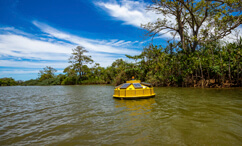
NEW MONITORING PORTAL EXPANDS ACCESS TO INFORMATION ON WATER QUALITY IN THE DOCE RIVER BASIN
Categories: Doce River Monitoring, Doce River Monitoring
RENOVA FOUNDATION PARTICIPATES IN THE LARGEST INTERNATIONAL CONFERENCE ON GEOGRAPHIC INFORMATION SYSTEMS
Categories: Water Monitoring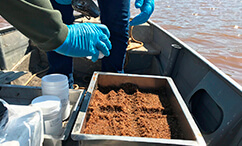
Residents Of Barra Do Riacho Follow The Water Monitoring In Aracruz Rivers (Es)
Categories: Water, Doce River Mouth Territory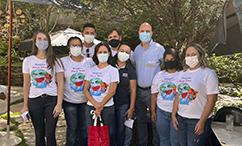
Doce Alive Project completes three years and contributes to the care of the water of the Doce River
Categories: Water
EXPEDITION CONDUCTS UNPRECEDENTED MAPPING OF THE DOCE RIVER AND RECEIVES VIRTUAL NAVIGATION PLATFORM
Categories: Water Monitoring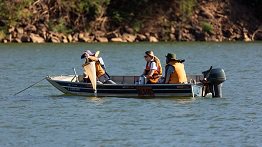
REPORT PRESENTS PARTIAL RESULTS OF DOCE RIVER BASIN WATER MONITORING
Categories: Water Monitoring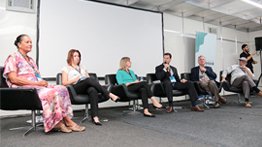
Renova's participation on the fourth day of the 8th World Water Forum
Categories: World Water Forum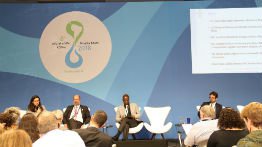
Ministers of numerous countries come together and call for the creation of a COP for water
Categories: Fórum Mundial da Água, World Water Forum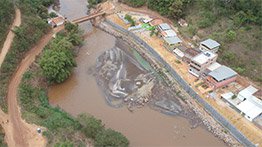
Prevention actions for the rainy season are underway in Barra Longa
Categories: Rainy Season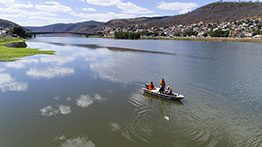
Igam study shows significant metal level drop in the Doce River
Categories: Water Management, Gestão das Águas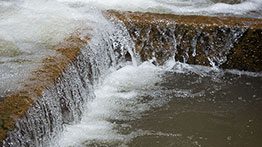
Renova Foundation organizes live talk on water management
Categories: Water Monitoring, Gestão da Água
Renova Foundation implements the Quali-Quantitative Systematic Monitoring Program for Doce River Water and Sediments
Categories: Water quality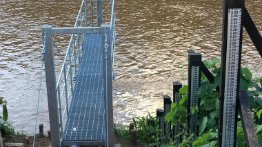
Minas Gerais features five new water monitoring stations
Categories: Water quality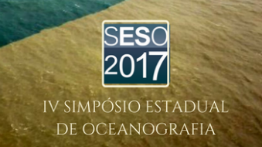
Renova Foundation participates in the IV State Symposium on Oceanography
Categories: Renova Foundation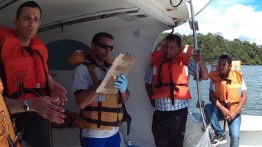
Indigenous communities participate in water quality monitoring
Categories: Water Monitoring